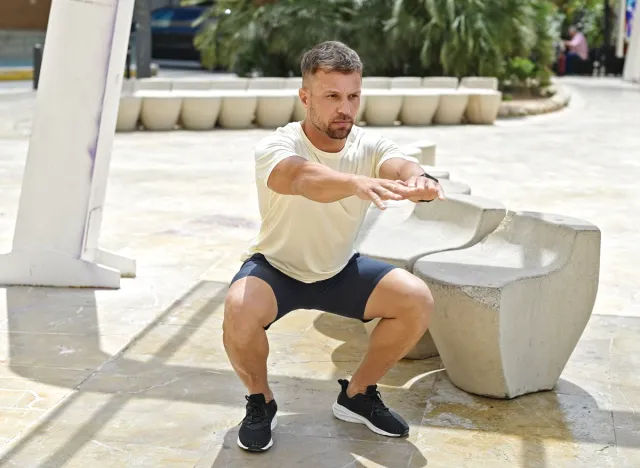I Tried 5 Viral Gym-Free Workouts and One Beat All the Rest

Scrolling through social media, it's impossible to miss the latest fitness trends promising quick gains, fat loss, and all-around transformation. But as a personal trainer, I know that not every viral workout is built for actual results. Some are just flashy fads, while others can be real game-changers. So, I decided to put five of the most hyped gym-free routines to the test.
From the treadmill-powered endurance challenge of the 12-3-30 Method to the intensity-driven intervals of the 10-20-30 Method, each workout offered a different spin on building strength, endurance, or overall fitness, no gym required. I pushed through every method for an entire week, analyzing how they felt in the moment and their impact on consistency, effectiveness, and overall results. Some left me drenched in sweat, others barely made a dent in my routine, but one stood out as the ultimate winner—a workout structure that made staying on track effortless.
The Viral Workouts I Tried
The 10-20-30 Method

What It Is: A high-intensity interval training (HIIT) protocol designed to enhance cardiovascular fitness and speed.
How It Works: This method involves a cycle of three intervals:
- 30 seconds at a low intensity (approximately 30% of maximum effort)
- 20 seconds at a moderate intensity (around 60% of maximum effort)
- 10 seconds at a high intensity (90% or more of maximum effort)
This sequence is repeated multiple times, typically for 5-minute blocks with rest periods in between.
My Experience: The 10-second high-intensity bursts were particularly challenging, pushing my limits and elevating my heart rate rapidly. The structured intervals made the workout engaging, and I noticed improvements in my sprinting capacity over the week. This workout was excellent when I had little time to crush a workout. As a personal trainer, I'd advise my clients only to use this method if they have a strong base-level of fitness—it'll catch up to you quickly!
The 12-3-30 Method

What It Is: A treadmill-based workout that emphasizes low-impact cardiovascular exercise.
How It Works: The routine consists of:
- Setting the treadmill to a 12% incline
- Walking at a speed of 3 miles per hour
- Maintaining this pace for 30 minutes
This method was popularized by influencer Lauren Giraldo, who credited it with significant weight loss and fitness improvements.
My Experience: The steep incline made the workout more demanding than a standard walk, especially when engaging my lower body muscles. It was manageable yet challenging, suitable for various fitness levels. I loved how I snuck a lot of work into a shorter amount of time. That's the beauty of gym-free workouts, right?
The 30-30-30 Method

What It Is: A morning regimen promoting weight loss and enhancing metabolic health.
How It Works: This routine involves key steps:
- Consume 30 grams of protein within the first 30 minutes of waking up.
- Engage in 30 minutes of low-intensity, steady-state cardio immediately after breakfast.
This method was first introduced by Tim Ferriss in his book The 4-Hour Body and later popularized by biologist Gary Brecka on social media platforms.
My Experience: Integrating this routine into my mornings required some adjustments, particularly in meal planning to ensure a protein-rich breakfast. The subsequent low-intensity cardio, such as brisk walking, felt manageable and set a positive tone for the day. Over a week, I observed improved satiety throughout the morning and gradually increased energy levels.
The 54321 Method

What It Is: A descending rep scheme workout blends various exercises to enhance overall fitness.
How It Works: The routine involves performing:
- 5 reps of a high-intensity exercise (e.g., burpees)
- 4 reps of a moderately intense exercise (e.g., jump squats)
- 3 reps of a moderate exercise (e.g., push-ups)
- 2 reps of a lower-intensity exercise (e.g., lunges)
- 1 rep of a core-focused exercise (e.g., plank hold)
This structure is repeated for several rounds, providing a comprehensive workout.
My Experience: The variety kept the workout engaging, and the descending reps provided a psychological boost as the set progressed. It effectively combined strength and cardio elements, making it a well-rounded routine.
The 3-2-1 Method

What It Is: A balanced workout regimen incorporating different exercise modalities throughout the week.
How It Works: The weekly structure includes:
- 3 days of strength training
- 2 days of Pilates or similar low-impact exercises
- 1 day of cardio or conditioning
This method ensures a holistic approach to fitness, targeting strength, flexibility, and cardiovascular health.
My Experience: The variety throughout the week prevented monotony and allowed different muscle groups to recover while others were engaged. It promoted a balanced fitness routine, catering to multiple aspects of health.
Which Viral Gym-Free Workout Worked Best?
After putting these five trending workouts to the test, the 3-2-1 Method stood out as the ultimate game-changer. Why? Because it did something that no other workout structure quite managed, it set me up for success throughout the week.
The 3-2-1 Method provided a blueprint. Its structured game plan made it easy to stay consistent, eliminating the guesswork of "What should I do today?" The combination of strength, cardio, and core work ensured a well-rounded routine, keeping me engaged while simultaneously hitting multiple fitness goals. Plus, the shorter strength and core sections allowed me to push harder without burning out before the cardio kicked in. That balance made a massive difference in adherence. I didn't feel drained or overwhelmed, and had enough left in the tank to conquer the next task.
Each of these workouts brings something valuable to the table, and if I've learned anything from this experiment, it's that variety is key. Mixing and matching these methods could be the perfect way to keep workouts fresh, avoid plateaus, and progress steadily toward your fitness goals without ever stepping into a gym.









